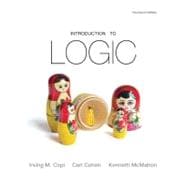
Note: Supplemental materials are not guaranteed with Rental or Used book purchases.
Purchase Benefits
What is included with this book?
Irving M. Copi was a philosopher and logician. He taught at the University of Illinois, the United States Air Force Academy, Princeton University, and the Georgetown University Logic Institute, before teaching logic at the University of Michigan, 1958-69, and at the University of Hawaii, 1969-90. His other works include Essentials of Logic, Informal Logic, and Symbolic Logic.
Carl Cohen is Professor of Philosophy at the Residential College of the University of Michigan. He has published many essays in moral and political philosophy in philosophical, medical, and legal journals. He has served as a member of the Medical School faculty of the University of Michigan, and as Chairman of the University of Michigan faculty, where he has been an active member of the philosophy faculty since 1955. His other works include The Animal Rights Debate (Rowman and Littlefield, 2001), with Prof. Tom Regan; he is also the author of Democracy (Macmillan, 1972); the author of Four Systems (Random House, 1982); the editor of Communism, Fascism, and Democracy (McGraw Hill, 1997); the co-author (with J. Sterba) of Affirmative Action and Racial Preference (Oxford, 2003)
Kenneth D. McMahon studied physics, philosophy, and English Literature as an undergraduate, then took graduate degrees in psychology and philosophy. He has taught critical thinking, philosophy, statistics, and psychology, and currently teaches logic for Hawaii Pacific University. His professional interests include logic, epistemology, philosophy of science, and philosophy of mind, as well as cognitive science, psychometrics, computational theories of mind, and evolutionary psychology.
Foreward
Preface
Acknowledgments
PART I LOGIC AND LAGUAGE
SECTION A REASONING
Chapter 1 Basic Logical Concepts
1.1 What Logic Is
1.2 Propositions and Arguments
1.3 Recognizing Arguments
1.4 Arguments and Explanations
1.5 Deductive and Inductive Arguments
1.6 Validity and Truth
Chapter 2 Analyzing Arguments
2.1 Paraphrasing Arguments
2.2 Diagramming Arguments
2.3 Complex Argumentative Passages
2.4 Problems in Reasoning
SECTION B INFORMAL LOGIC
Chapter 3 Language and Definitions
3.1 Language Functions
3.2 Emotive Language, Neutral Language, and Disputes
3.3 Disputes and Ambiguity
3.4 Definitions and Their Uses
3.5 The Structure of Definitions: Extension and Intension
3.6 Definition by Genus and Difference
Chapter 4 Fallacies
4.1 What Is a Fallacy?
4.2 Classification of Fallacies
4.3 Fallacies of Relevance
4.4 Fallacies of Defective Induction
4.5 Fallacies of Presumption
4.6 Fallacies of Ambiguity
Part II Deduction
Section A Classical Logic
Chapter 5 Categorical Propositions
5.1 The Theory of Deduction
5.2 Classes and Categorical Propositions
5.3 The Four Kinds of Categorical Propositions
5.4 Quality, Quantity, and Distribution
5.5 The Traditional Square of Opposition
5.6 Further Immediate Inferences
5.7 Existential Import and the Interpretation of Categorical Propositions
5.8 Symbolism and Diagrams for Categorical Propositions
Chapter 6 Categorical Syllogisms
6.1 Standard-Form Categorical Syllogisms
6.2 The Formal Nature of Syllogistic Argument
6.3 Venn Diagram Technique for Testing Syllogisms
6.4 Syllogistic Rules and Syllogistic Fallacies
6.5 Exposition of the Fifteen Valid Forms of the Categorical Syllogism
Appendix: Deduction of the Fifteen Valid Forms of the Categorical Syllogism
Chapter 7 Syllogisms in Ordinary Language
7.1 Syllogistic Arguments
7.2 Reducing the Number of Terms to Three
7.3 Translating Categorical Propositions into Standard Form
7.4 Uniform Translation
7.5 Enthymemes
7.6 Sorites
7.7 Disjunctive and Hypothetical Syllogisms
7.8 The Dilemma
Section B Modern Logic
Chapter 8 Symbolic Logic
8.1 Modern Logic and Its Symbolic Language
8.2 The Symbols for Conjunction, Negation, and Disjunction
8.3 Conditional Statements and Material Implication
8.4 Argument Forms and Refutation by Logical Analogy
8.5 The Precise Meaning of “Invalid” and “Valid”
8.6 Testing Argument Validity Using Truth Tables
8.7 Some Common Argument Forms
8. 8 Statement Forms and Material Equivalence
8.9 Logical Equivalence
8.10 The Three “Laws of Thought”
Chapter 9 Methods of Deduction
9.1 Formal Proof of Validity
9.2 The Elementary Valid Argument Forms
9.3 Formal Proofs of Validity Exhibited
9.4 Constructing Formal Proofs of Validity
9.5 Constructing More Extended Formal Proofs
9.6 Expanding the Rules of Inference: Replacement Rules
9.7 The System of Natural Deduction
9.8 Constructing Formal Proofs Using the Nineteen Rules of Inference
9.9 Proof of Invalidity
9.10 Inconsistency
9.11 Indirect Proof of Validity
9.12 Shorter Truth-Table Technique
Chapter 10 Quantification Theory
10.1 The Need for Quantification
10.2 Singular Propositions
10.3 Universal and Existential Quantifiers
10.4 Traditional Subject—Predicate Propositions
10.5 Proving Validity
10.6 Proving Invalidity
10.7 Asyllogistic Inference
Part III Induction
Section A Analogy and Causation
Chapter 11 Analogical Reasoning
11.1 Induction and Deduction Revisited
11.2 Argument by Analogy
11.3 Appraising Analogical Arguments
11.4 Refutation by Logical Analogy
Chapter 12 Causal Reasoning
12.1 Cause and Effect
12.2 Causal Laws and the Uniformity of Nature
12.3 Induction by Simple Enumeration
12.4 Methods of Causal Analysis
12.5 Limitations of Inductive Techniques
Section B Science and Probability
Chapter 13 Science and Hypothesis
13.1 Scientific Explanation
13.2 Scientific Inquiry: Hypothesis and Confirmation
13.3 Evaluating Scientific Explanations
13.4 Classification as Hypothesis
Chapter 14 Probability
14.1 Alternative Conceptions of Probability
14.2 The Probability Calculus
14.3 Probability in Everyday Life
Appendix
Solutions to Selected Exercises
Glossary/Index
The New copy of this book will include any supplemental materials advertised. Please check the title of the book to determine if it should include any access cards, study guides, lab manuals, CDs, etc.
The Used, Rental and eBook copies of this book are not guaranteed to include any supplemental materials. Typically, only the book itself is included. This is true even if the title states it includes any access cards, study guides, lab manuals, CDs, etc.